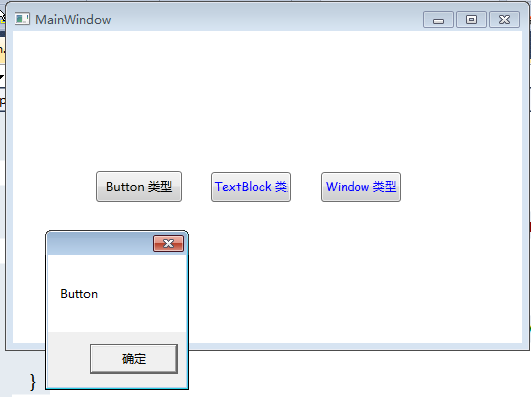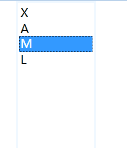标记扩展一般含有 {} 符号
x:Type 传入操作数据类型
x:Null 空值
通过例子看下具体:
(前台XAML代码)
<Window x:Class="WpfApplication1.MainWindow" x:ClassModifier="public"
xmlns="http://schemas.microsoft.com/winfx/2006/xaml/presentation"
xmlns:x="http://schemas.microsoft.com/winfx/2006/xaml"
xmlns:sys="clr-namespace:System;assembly=mscorlib"
xmlns:local="clr-namespace:WpfApplication1"
Title="MainWindow" Height="350" Width="525">
<Window.Resources>
<Style x:Key="{x:Type local:UCButton}" TargetType="Button">
<Setter Property="Width" Value="80"/>
<Setter Property="Height" Value="30" />
<Setter Property="FontFamily" Value="Comic Sans MS" />
<Setter Property="Foreground" Value="Blue"/>
</Style>
</Window.Resources>
<Grid>
<local:UCButton myType="{x:Type Button}" Style="{x:Null}" Margin="83,140,340,141" Content="Button 类型" />
<local:UCButton myType="{x:Type Window}" Margin="305,140,118,141" Content="Window 类型" />
<local:UCButton myType="{x:Type TextBlock}" Margin="195,140,228,141" Content="TextBlock 类型" />
</Grid>
</Window>
(后台C#代码 ,UCButton.cs)
public class UCButton:Button { public Type myType{get;set;} //传入类型 /// <summary> /// 重写点击事件 /// </summary> protected override void OnClick() { base.OnClick(); //所有控件基类,反射生成对象 FrameworkElement element = Activator.CreateInstance(this.myType) as FrameworkElement; if (element != null) { MessageBox.Show(element.GetType().Name); //显示对应类型 } } }
上面用到地方有两处,
1.页面资源样式共享,目标对象UCButton,然后 Style="{x:Null}",不用于当前按钮。
2.传入类型不同,点击显示不同。
效果图:

x:Array 数组源对象
<ListBox BorderBrush="AliceBlue" BorderThickness="2" Width="80" >
<ListBox.ItemsSource>
<x:Array Type="sys:String">
<sys:String>X</sys:String>
<sys:String>A</sys:String>
<sys:String>M</sys:String>
<sys:String>L</sys:String>
</x:Array>
</ListBox.ItemsSource>
</ListBox>

x:Static
引用静态变量
public static string WindowText = "静态变量";
<Button Width="80" Height="30" Content="{x:Static local:MainWindow.WindowText}"/>





















 被折叠的 条评论
为什么被折叠?
被折叠的 条评论
为什么被折叠?








